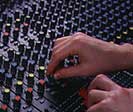| Author
|
Identifiying the frequencies
|
Newbie2006
IsraTrance Junior Member
Started Topics :
11
Posts :
29
Posted : Jan 9, 2007 03:01
|
Hello,
Each time I visit this forum I learn something usefull new.
This might be simple to some of you but I am failling to identify the frequencies.
For instance, when you say you must Hi pass below 35Hz to remove the lowest bass (or the kick and the bass will have a highpass at 16-30 Hz).
Is this done before you import the samples into project or after? Is it done with hardware (outboard mixers) or soft plugins? or combination of both?
I use cubase sx mostly. How do you high pass kick and the bass at 16-30 Hz? Within channel dynamics using various plugins and cubase's own eq?
Thanks for your patience.
peace,
N |

|
|
Saf

Started Topics :
5
Posts :
210
Posted : Jan 9, 2007 03:11
|
On the Cubase built in eq, I usually put a highpass at about 50-60hz, and then a lowpass 2khz-2.2hz, but that is specific to your bass sound.
I don't highpass my kick. I really don't do anything at all to my kicks.
I also highpass filter just about everything else in my tracks someway to keep it away from the bass at maybe, 250hz.
Good question though, are other people highpassing their kicks? Why?
|

|
|
bukboy
Hyperboreans

Started Topics :
40
Posts :
803
Posted : Jan 9, 2007 10:34
|
What u can do is run your bass sound thru a spectrum analyser on the output and compare it to the spectrum of a bass sound u like. Then use an eq to massage the sound u want 2 have a similar spectrum to the original bass.
Works for me.
Ofcourse there are complexities in any sound which have to be eq'd but the thing about this method is that u can easily find out where to put at least the highpass and lowpass.
U can to some degree also see the harmonics and how they have been eq'd and get some insight in2 how to make that bass.
Running a spectrum analyser(voxengo span) and a temporal analyser(smexoscope) on the output of a track will greatly help u understand Y a sound sounds the way it does. 
Ciao |

|
|
Kane
IsraTrance Junior Member

Started Topics :
23
Posts :
1772
Posted : Jan 9, 2007 14:32
|
Never fully eliminate a frequency range. Ever.
The point of EQing is to, for example, get rid of some of the treble in your basslines, some of the bass in your leads, for example..not to cut out what you don't think matters.. |

|
|
Sound Surgeon
Crater / Mish-kah

Started Topics :
250
Posts :
2244
Posted : Jan 9, 2007 16:46
|
sometimes i make lowpass to my kicks, but thats only when i want "low-freq" mostly kickdrums. i dont make any high-low bypassing on my basses though, you can use cutoff for it 
|

|
|
Sound Surgeon
Crater / Mish-kah

Started Topics :
250
Posts :
2244
Posted : Jan 9, 2007 16:48
|
|
Why do you need to cut 16-35? you cant hear that stuff...so leave that to mastering or something like that. dont cut that.
|

|
|
shamantrixx

Started Topics :
7
Posts :
549
Posted : Jan 9, 2007 17:52
|
Quote:
|
On 2007-01-09 16:48, Sound Surgeon wrote:
Why do you need to cut 16-35? you cant hear that stuff...so leave that to mastering or something like that. dont cut that.
|
|
you can't hear 16 - 30 Hz but you can hear the difference when you remove this part of freq. range. And I don't mean some minor difference... the difference is huge.
When mastering proces removes the low end some middle sounds will get accented due to aditional power available in the mix. But you'll no longer be around to decide what to do with that few extra dB and you could get your track back with completly different tonal balance. Sometimes it can get better than it was and sometimes you get crap out of it... and you can't ask your money back.
Spectrum analyser should be visible ALL THE TIME. Otherwise it's like you're building a house without ruler, compass and blueprint.
        "It occurred to me by intuition, and music was the driving force behind that intuition. My discovery was the result of musical perception" "It occurred to me by intuition, and music was the driving force behind that intuition. My discovery was the result of musical perception"
Albert Einstein, speaking about his theory of relativity |

|
|
Freeflow
IsraTrance Full Member

Started Topics :
60
Posts :
3709
Posted : Jan 9, 2007 19:48
|
"Spectrum analyser should be visible ALL THE TIME. Otherwise it's like you're building a house without ruler, compass and blueprint."
i dont know if i can agree to this, building music and houses are two different things, when you work with music you use your ears, so they are the rule, compass.
its a good reference to have a spectrum analyser but i think if you want to train your ears you should not grab it in the first place. Sometimes its better to close your eyes instead.
other than that i do agree.
|

|
|
Freeflow
IsraTrance Full Member

Started Topics :
60
Posts :
3709
Posted : Jan 9, 2007 20:00
|
Quote:
|
On 2007-01-09 03:01, Newbie2006 wrote:
Hello,
Each time I visit this forum I learn something usefull new.
This might be simple to some of you but I am failling to identify the frequencies.
For instance, when you say you must Hi pass below 35Hz to remove the lowest bass (or the kick and the bass will have a highpass at 16-30 Hz).
Is this done before you import the samples into project or after? Is it done with hardware (outboard mixers) or soft plugins? or combination of both?
I use cubase sx mostly. How do you high pass kick and the bass at 16-30 Hz? Within channel dynamics using various plugins and cubase's own eq?
Thanks for your patience.
peace,
N
|
|
everybody works differently, manipulating your sounds before they are in context to the other sounds might not be a good idea. but if you know exactly what needs to be done, than do it 
about using a mixers Eq to sculp the sound can be a great idea. good mixerboards will have quality Eq´s. and are easy to dial i nthe right setting by using your ears.
|

|
|
Djones
IsraTrance Senior Member

Started Topics :
267
Posts :
1766
Posted : Jan 9, 2007 21:37
|
|
Maybe a real dumb question, but what is the difference between a highpass and a lowcut filter? |

|
|
shamantrixx

Started Topics :
7
Posts :
549
Posted : Jan 10, 2007 03:25
|
I think there's no difference. Just depends from the point of view. Mostly low cut filter will be fixed to (or below) 32 Hz while hi pass filter will extend to full range. But other than that I see no difference.
@ freeflow: of course you have to use your ears to decide what sounds good and what sounds like crap... but there are situations when due to the tone masking you simply can't hear what is otherwise obvious in the spectrum analyzer. For instance... when I use FM synthesis often there's a "bump" below 50 Hz that simply wastes power and makes groove muddy. Due to louder and resonant sound in the middle of the spectrum (like 100 to 500 Hz) you can't hear the 20-50 Hz "bump".
In other words... spec. an. will warn you about potential clashes and muddy areas long before you get in a "head scratch" situation. And beside that... I see no harm in having it always in sight just as long as you focus on sound rather than on graphics 
        "It occurred to me by intuition, and music was the driving force behind that intuition. My discovery was the result of musical perception" "It occurred to me by intuition, and music was the driving force behind that intuition. My discovery was the result of musical perception"
Albert Einstein, speaking about his theory of relativity |

|
|
Newbie2006
IsraTrance Junior Member
Started Topics :
11
Posts :
29
Posted : Jan 10, 2007 05:41
|
Quote:
|
On 2007-01-09 16:48, Sound Surgeon wrote:
Why do you need to cut 16-35? you cant hear that stuff...so leave that to mastering or something like that. dont cut that.
|
|
LOL...well that was just and example. I wanted to know how you guys figure out these frequencies (any frequency) with what tools to analyz and cut-it out.
Thanks.
N |

|
|
Newbie2006
IsraTrance Junior Member
Started Topics :
11
Posts :
29
Posted : Jan 10, 2007 05:44
|
Quote:
|
On 2007-01-09 21:37, Djones wrote:
Maybe a real dumb question, but what is the difference between a highpass and a lowcut filter?
|
|
hey man ..no question is dump question!  |

|
|
mk47
Inactive User

Started Topics :
118
Posts :
4444
Posted : Jan 10, 2007 07:04
|
highpass removes the low freqs
lowpass removes the high freqs
tho not completely ..(-3db). most filters .. or so iv read here somewhere . im presuming lowpass = lowcut . is there such a thing as a brickwall filter with completely removes the freqs after applying ? if so .. wich ones ? are the results very diffrent from say .the waves REQ filters ? what are the advantages /disadvantages ?
|

|
|
Saf

Started Topics :
5
Posts :
210
Posted : Jan 10, 2007 08:11
|
I am pretty sure lowpass is another name for highcut, and lowcut for highpass, think about it.
I think filters always end up having a slope of so many dB per octave, for instance you can choose 12 or 24 like on the Albino Filter.
I don't think it is possible to create a filter kernel which brickwalls at a certain frequency due to the way the kernel is convolved with the signal it can not simply cut off exactly to zero at X hz.
It might be possible to transform the audio signal into the frequency domain and simply delete the frequencies below X hz and then invert back to the time domain, but my intuition says that would sound really really bad.
I'm currently learning about filters and some of the math behind them, so anyone feel free to correct my mistakes.
Good free book that explains filters and other DSP things http://dspguide.com/ |

|
|